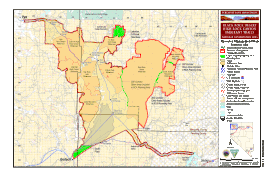
Back صحراء بلاك روك Arabic صحرا بلاك روك ARZ Desiertu de Black Rock AST Blək-Rok (səhra) Azerbaijani Блек Рок (пустиня) Bulgarian Desert de Black Rock Catalan Black Rock Desert CEB Black Rock Desert Czech Black Rock Desert German Desierto de Black Rock Spanish
| Black Rock Desert | |
|---|---|
 | |
| Length | 100 mi (160 km) |
| Area | 1,000 sq mi (2,600 km2) |
| Geography | |
| Location |  |
| Country | United States |
| State | Nevada |
| County | |
| Population center | Gerlach, Nevada |
| Coordinates | 40°52′59″N 119°03′50″W / 40.88306°N 119.06389°W |
| River | Quinn River |
The Black Rock Desert is a semi-arid region (in the Great Basin shrub steppe ecoregion) of lava beds and playa, or alkali flats, situated in the Black Rock Desert–High Rock Canyon Emigrant Trails National Conservation Area, a silt playa 100 miles (160 km) north of Reno, Nevada, that encompasses more than 300,000 acres (120,000 ha) of land and contains more than 120 miles (200 km) of historic trails. It is in the northern Nevada section of the Great Basin with a lakebed that is a dry remnant of Pleistocene Lake Lahontan.
The Great Basin, named for the geography in which water is unable to flow out and remains in the basin, is a rugged land serrated by hundreds of mountain ranges, dried by wind and sun, with spectacular skies and scenic landscapes.[1] The average annual precipitation (in the years 1971–2000) at Gerlach (in the extreme south-west of the desert) is 7.90 inches (200 mm).[2]
The region is notable for its paleogeologic features, as an area of 19th-century Emigrant Trails to California, as a venue for rocketry, and as an alternative to the Bonneville Salt Flats in northwestern Utah for setting land speed records (Mach 1.02 in 1997). It is also the location for the annual Burning Man event.
The Black Rock Desert is part of the National Conservation Area (NCA), a unit of the Bureau of Land Management (BLM) National Landscape Conservation System (NLCS). The NCA is located in northwest Nevada and was established by legislation in 2000. It is a unique combination of the desert playa, narrow canyons, and mountainous areas.
Humans have been in Black Rock Desert since approximately 10,000 B.P.[3] Around 1300 CE, the area was settled by the Paiute people.[4][5] The Desert's namesake large, black rock formation was used as a landmark by the Paiute and later emigrants crossing the area. The landmark is a conical outcrop composed of interbedded Permian marine limestone and volcanic rocks.[6] At its base is a large hot spring and grassy meadow, which was an important place for those crossing the desert headed for California and Oregon. In 1843, John Frémont and his party were the first white men to cross the desert, and his trail was used by over half of the 22,000 gold seekers headed to California after 1849. In 1867, Hardin City, a short-lived silver mill town, was established (now a ghost town).
- ^ "General Information". Friends of Black Rock High Rock. Archived from the original on September 2, 2012. Retrieved September 1, 2012.
- ^ "Climate Normals". Ggweather.com. Retrieved August 27, 2014.
- ^ Connolly, Thomas J.; Barker, Pat; Fowler, Catherine S.; Hattori, Eugene M. (July 2016). "Getting beyond the Point: Textiles of the Terminal Pleistocene/Early Holocene in the Northwestern Great Basin". American Antiquity. 81 (3): 490–514. doi:10.1017/S0002731600003966. S2CID 220444994. Retrieved June 3, 2019.
Elephant Mountain Cave (26HU-3557-sd2), ca. 9700 cal B.P.
- ^ Naval Air Station Fallon Geothermal Energy Development for Generation of Electrical Power, Churchill County: Environmental Impact Statement, Part 2 (Report). United States Navy. p. 114. Retrieved September 3, 2019.
Layton suggests little use of the High Rock Country from ca. AD 200–1300, with the population possibly emigrating to Surprise Valley.
- ^ Wheeler, Sessions S. (1978). The Black Rock Desert. Caxton Press. p. 32. ISBN 978-0-87004-258-4.
When the first white man arrived, the region known as northwestern Nevada was occupied by the Northern Paiute people. Cave excavations have provided evidence that these Indians did not come to this section of the Great Basin until approximately 1,400 A.D. and that at least three other separate cultures of people preceded them.
- ^ "Gianella, V. P., and Larson, E. R., 1960, Marine Permian at Black Rock, Nevada: Geol. Soc. Amer, Abstract of meetings, Vancouver" (PDF). Retrieved August 27, 2014.